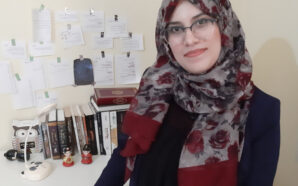 The Middle East and North Africa (MENA) region has witnessed positive growth over the past one decade, essentially fuelled by the government’s willingness to migrate from energy-based economies to knowledge-based ones. It is indeed not untrue to claim that long-term sustainability as well as societal welfare can only be possible by incorporating women’s participation in regional economic activity, especially in the areas of Science, Technology, Engineering and Math (STEM), to harness the MENA’s full productive potential. Although there has been a limited representation of women in STEM education globally, the scenario is quite positive as far as the Arabian Peninsula is concerned.
The Middle East and North Africa (MENA) region has witnessed positive growth over the past one decade, essentially fuelled by the government’s willingness to migrate from energy-based economies to knowledge-based ones. It is indeed not untrue to claim that long-term sustainability as well as societal welfare can only be possible by incorporating women’s participation in regional economic activity, especially in the areas of Science, Technology, Engineering and Math (STEM), to harness the MENA’s full productive potential. Although there has been a limited representation of women in STEM education globally, the scenario is quite positive as far as the Arabian Peninsula is concerned.
Talking about the female student population especially in the STEM fields, Heriot-Watt’s Postgraduate Director of Studies and Lecturer in Computer Science, School of Mathematical & Computer Sciences, Dr. Hind Zantout comments, “It is very interesting to note that more and more girls belonging to many Arab countries, as well as from Indonesia and Malaysia, are studying engineering, science or technology compared to those in Switzerland or Germany, for example. This is an extremely positive sign.”
Dr. Hind cites a number of reasons for this upward trend in women’s education. “I believe it is imperative to have the right set of programmes. If you have one based only on theoretical knowledge, people start losing interest. I can quote a student of mine who had once told a visiting computer science teacher that she chose the subject because she liked doing things practically. I think the crux of the matter is to develop a course that essentially stimulates students into action. So the kind of course you are putting together is very important. It is all about creating the right sequence of practice and theory.”
I believe it is imperative to have the right set of programmes. If you have one based only on theoretical knowledge, people start losing interest.
Women enrolment in STEM-based education in countries such as the US and UK have experienced a decline over the last few years, while it has comparatively increased in the Arab region. A report published by the ICEF Monitor, a dedicated market intelligence resource for the international education industry had earlier stated: “The Middle East continues to see dramatic growth in education capacity, driven especially by booming population growth and burgeoning demand for tertiary education by women. Aside from simply keeping up with demand, it seems clear that these significant new investments are being made with a larger purpose. Scientific research and innovation in the region, and increasingly education – applied sciences, research, and technology in particular – are seen as an important driver of social and economic development.”
Acknowledging the greater demand of higher and specialized education among women in the Middle East and particularly in the UAE, Dr. Hind remarks, “In our field of computing, the percentage of women students is higher compared to that in other campuses. About 30% of students enrolled in Heriot-Watt University Dubai Campus are women as opposed to merely 11% in the Edinburgh campus. Girls here are more outspoken and have a go-getter attitude. This may have a lot to do with UAE’s diverse population – expatriates and Emiratis – that opens up a world for them. Coupled with the very high penetration of mobile phones in the UAE, it really does make sense that girls want to try their hands in this field.”
About 30% of students enrolled in Heriot-Watt University Dubai Campus are women as opposed to merely 11% in the Edinburgh campus.
She further adds, “It is a very interesting topic to study Dubai in the context of gender issues. In my experience, the most engaged students are girls. I also think it’s the environment that guides them to be proactive and wanting to do what they are doing. An encouraging environment and open-mindedness are key instigators for progress, and you have these elements working for you here in Dubai!”
While women have made headway in STEM education, they still lag behind men as far as pursuing careers or retaining high-ranking positions are concerned. According to a report Accelerating growth: Women in science and technology in the Arab Middle East by the Economist Intelligence Unit: “In Palestine, 56% of undergraduate enrolments in 2010 were women, compared to 47% a decade earlier. This is especially pronounced in science: in Saudi Arabia, 65% of all enrolments in science degrees in 2010 were women, versus 40% a decade earlier. But the rising number of Arab women graduating in science is not translating into more women scientists in the workplace. Women account for just 1% of researchers in Saudi Arabia, 19% in Palestine and 22% in Libya, markedly lower than the world average of 30%. And despite their high proportions in undergraduate places, many do not pursue postgraduate research. Women make up just 34% of participants in science masters courses in Saudi Arabia, and 29% in PhD programmes.”
Lamenting the issue, Dr. Hind opines, “Indeed, the conversion rate for girl students to becoming professionals or pursuing careers is comparatively low especially in traditional communities. But this can be addressed by businesses becoming more flexible. For instance, if you are a computer science graduate and a mom, you can easily work two to three days from home. I think the business world needs to accommodate women better in the workplace.”
Indeed, the conversion rate for girl students to becoming professionals or pursuing careers is comparatively low especially in traditional communities. But this can be addressed by businesses becoming more flexible.
Overall, stakeholders – business leaders, communities and governments – will not only have to rethink their policies to motivate women in STEM to participate in the workforce, they will also have to find the means to reconnect professionally educated women with the job market.
“The current situation has to change. Money literally goes down the drain if women are unable to pursue careers due to familial and societal issues either after they graduate or go on a hiatus. On the other hand, there is a widening gap of relevant human resources. In the long run, it is not sustainable to get people from outside when equally talented women are present. The key here is to invest in training women out of touch due to parental leaves, etc., in order to reintroduce them into the world of business,” concludes Dr. Hind.










